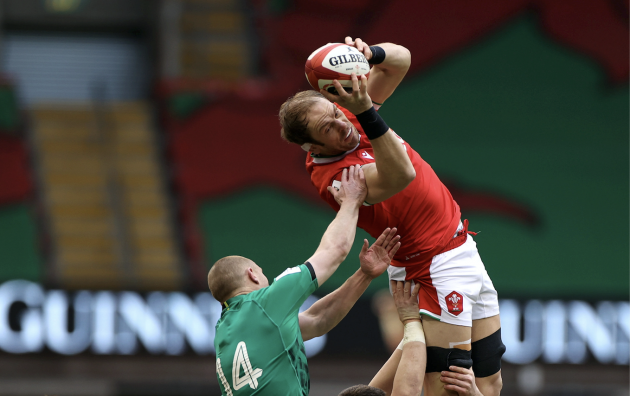Geraint Davies and the team at Bajad8a break down the building blocks of elite rugby, starting with an analysis of the restart
Rugby Explained: Kick-offs as the third set-piece
When we talk about set-piece we often think about scrum and lineout. However, restarts are more than worthy holders of the third set-piece title. In fact, rugby relies on them to begin play at the start of each half and after any score, making them perhaps the most important set-piece of all. So, how are teams using restarts to gain tactical advantage?
The key features of a set-piece are that both the attack and the defence have time to consider their options before the ball comes into play, in addition to the set roles players tend to perform. Teams have a set plan before the ball comes into play, sometimes for up to five phases, but generally for two to three phases. So let me explain some of the planning that takes place before a kick-off and what teams hope to achieve.
If we look at the set-up for both Leinster (blue) and Munster (red) from their Guinness Pro14 clash in January 2021 (Figure 1), it’s clear that there’s a well-planned and thought-out strategy in place for both teams.
For Leinster they have their wingers split on the outside edges of the field with the centres (12, 13) also split either side. Inside of that are seven of the eight forwards, again split either side of the kicker, Johnny Sexton. Each of those players form what is called the ‘chase team’ and, as the name implies, will chase wherever the ball is kicked.

Figure 1: Kick off set up for Munster v Leinster, Pro14 2021.
The players not in the chase line have responsibility for covering the space that remains behind the chase line and the way teams do this has a huge impact on the way an attack will choose to exit their own territory (run/kick).
For example, if the kicking team keep four players back, that leaves 11 players in the defensive line and the receiving team has opportunity to run. If the kicking team keep two back with 13 in the front line, there’s more space to kick.
A key tactical consideration for both teams is where the kicking team kicks. To make sense of this aspect of play it’s useful to split the field into six kicking zones as shown in Figure 2.
The statistics shown in Figure 2 are based on 110 kick-offs by five different teams when playing five different opponents in the 2020-21 Pro14. There are obvious issues with averages in analysis as there is always a great deal of inter-team variation. For example, the Ospreys kick to zones 1 and 3 on 36% and 32% of occasions respectively. Whereas Leinster kicked to zone 1 on only 5% of occasions and to zone 3 on 45% of restarts.
However, identifying general trends can be useful in this case. What is clear is that teams favour kicks to either the left or right zones and rarely kick to the centre of the field, something that is consistent across all competitions in professional rugby.

Figure 2: Kick-off zones. The six areas teams pre-plan kick-offs for
The question is, why? The answer to this question demonstrates why kick-offs are very much a set-piece.
The aim for the kicking team is to get the ball back. However, this is rarely achieved by trying to catch the ball directly by kicking short into to the front of zones 1, 2, or 3. The main three reasons are the potential for a chasing player to knock the ball on, the tactics used by the receiving team to prevent this from happening and, finally, if the receiving team catch the ball they are in a strong position to kick or run into opposition territory.
Related: Goal-line drop-outs among new Super Rugby law variations
So instead of kicking short, teams aim kick-offs high, targeting the 10m area either in front or behind the 22m line (zones 1, 3, 4, 6). The chasing team, often led by the wingers and centres who aim to pressure the catcher, either by jumping to contest possession, which can disrupt the catcher and force an error, or alternatively by arriving at the moment the ball is caught and making an offensive tackle.
This is the reason you see flankers and second-rows holding next to centres in Figures 1 and 2. Those players are responsible for challenging the ruck and putting the opposition under enough pressure to force a handling error or kick under pressure. The potential outcomes for the kicking team are winning a scrum by forcing a knock-on, a penalty by challenging the ruck, a lineout if the opposition kick the ball to touch, or they can get the ball back as the opposition kick it away.

Figure 3: Kick-off chase and backfield coverage
In order to prepare for each of these outcomes, Figure 3 demonstrates how the backfield is managed and how a team would counteract the measures taken by the receiving team to exit their territory.
From Figure 1 we can see that 15 has moved to the left touchline due to his ability to catch high balls and to kick if required. The No 8 has dropped to centrefield and is there to support the 15 in contact or to act as a ball-carrier, gaining valuable territory for the kicking team.
This piece was written by Geraint Davies – part of the Bajad8a collective.
Can’t get to the shops? You can download the digital edition of Rugby World straight to your tablet or subscribe to the print edition to get the magazine delivered to your door.
Follow Rugby World on Facebook, Instagram and Twitter.





